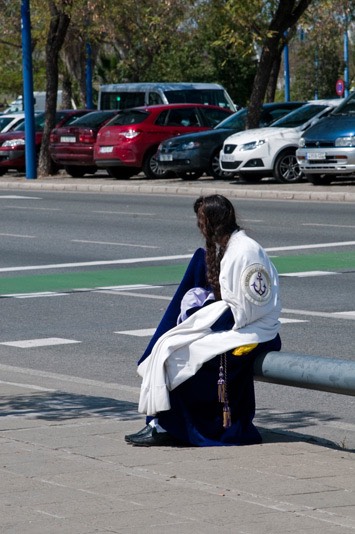
Holy Week or Semana Santa is the highlight in Christian Spain's calendar. Processions of penitents wearing hooded robes accompany huge decorated floats bearing carved images of the crucifixion scene or the Virgin Mary. Much of this takes place at night, which contributes to the eeriness of the spectacle.
During Semana Santa or Holy Week, starting on Palm Sunday before Easter, processions take place in every town in Andalucia. On Maundy Thursday, we witnessed the procession in neighbouring Moguer, where most of the penitents (nazarenos) seemed to be children! Not all of them wore their pointed hoods fully covering their faces for the entire time, sometimes looking like they were auditioning for a Harry Potter movie. The procession made its way slowly through the village, past the town hall and the church, with frequent stops for those carrying the float (paso) with a crucifixion scene to get some rest. The floats are carried by so called costaleros on their shoulders and necks! During the procession, pictures of Jesus and the virgin are handed out, and children collect wax from the candles carried by the nazarenos; some building up quite large wax balls. Being a small town, the whole mood was relaxed and easy-going; the streets filled by people watching and mingling with the procession.




The most impressive Easter processions nearby are those in Sevilla. Between Palm Sunday and Easter Sunday, some 69 processions take place. Each brotherhood (hermandad) follows a traditional route from their church to the cathedral and back. Most processions leave in the late afternoons and evenings, and many take until the early hours of the morning to return to their churches. The highlight starts in the early hours of Good Friday, the Madrugá, when the first processions leave just after midnight, and the last ones only return to their churches around midday. Some of them are on the move for some 14 hours! All processions come through the same narrow streets outside the cathedral, where seats are set out that can be rented for an extravagant price. Seeing the processions in the city centre is otherwise not so easy, as the police close roads to make sure that the processions can move freely. There are "pedestrian crossing points", where one can get a glimpse of the processions, but it is better to find a good place a little further away from the cathedral. Crowds form everywhere as soon as a procession comes near. At night, and with slow shutter speeds, photos can express the eerie nature of the processions.

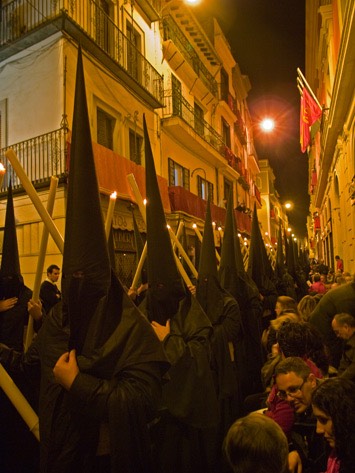


All hermandads wear their own characteristic robes and hoods, and experts and avid followers can easily tell them apart. The following photos show the nazarenos of the hermandad Pasión, who are completely dressed in black. At night, most nazarenos carry lit candles, and many of the robes (and the streets!) end up splattered with different coloured wax. Some penitents carry crosses, and they are the only nazarenos who don't wear the characteristic pointed hoods (capirote). As all one can see is the eyes, the whole experience is somewhat spooky! All processions include at least two floats with life-size or bigger figures; one is a scene of the crucifixion and the other is of the Virgin Mary. Some hermandads also have a third float with a statue of Jesus. These big floats in Sevilla often weigh more than a ton and are carried by up to 50 men each. Each of the floats has some overseers on the outside, who give instructions to the costaleros underneath, guiding them with precision through the crowds, down narrow streets and around tight corners.






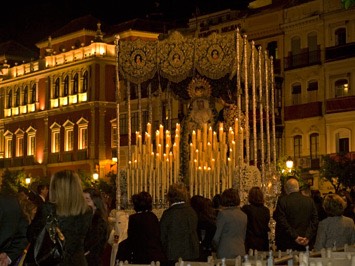

One of the most famous processions is that of "La Esperanza de Triana", which together with the one from Macarena is the longest and contains most nazarenos. The procession from Triana takes around twelve hours for the round trip and approximately 2,150 nazarenos take part in it. It takes nearly 90 minutes for the whole procession to pass any one place!
The hermandad of Triana dates back to 1418. The nazarenos walking in front of the float depicting Jesus and the cross and a Roman soldier on horseback wear purple and white robes, and those who are associated with the float of the virgin or "Our Lady of Hope" (Nuestra Señora de la Esperanza) as she is known, wear dark green and white robes.

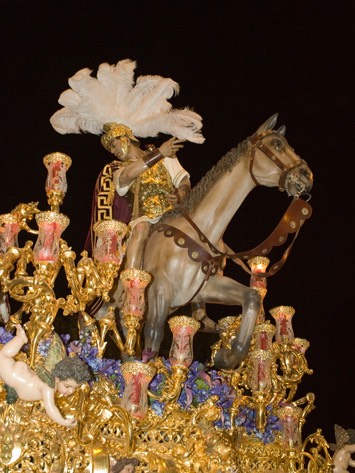


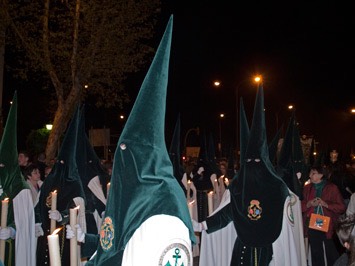

Candles are carried by the nazarenos, but they are only lit at night. It is a special treat for children to collect the wax. Bystanders also cherish the photos depicting Jesus and the Virgin that are handed out by some of the nazarenos. It is a strange experience to watch all these anonymous hooded people walking past. The amazing thing is though, that some bystanders recognise their friends and relatives under the hoods and stop for a chat! It's all in the eyes...
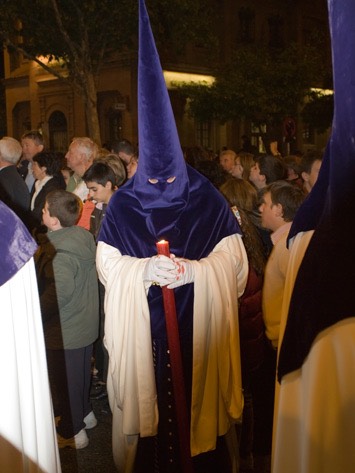





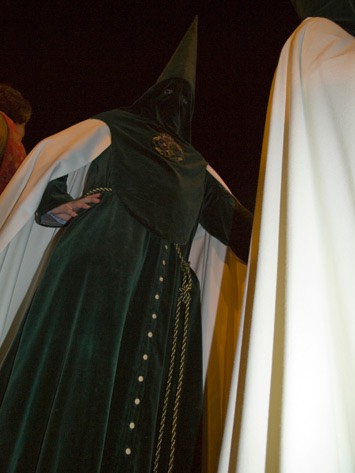
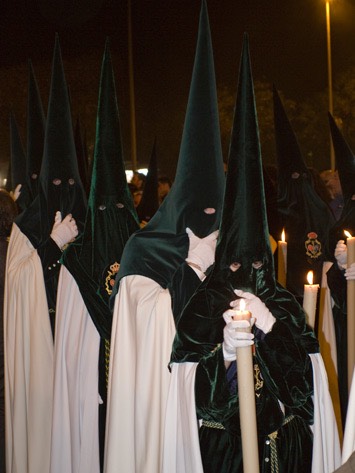
Most processions include two or three bands, that play a very characteristic and at the same time very strange type of music. Most are brass bands and include several ranks of drummers, who's solemn beat can be heard at a great distance.


As night temperatures were very cold on Maundy Thursday 2012, we went to Sevilla in the mid-morning of Good Friday, when we met up with the Triana procession just coming to the bridge over the river Guadalquivir and heading back into Triana. Even in daylight, the hooded nazarenos still seemed somewhat ominous!
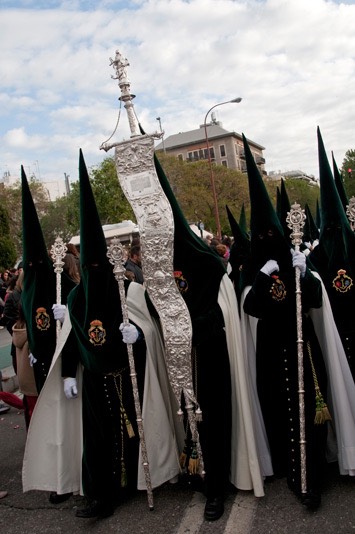





Some of the nazarenos, who feel the need for special penitence, walk the whole distance in socks or even barefoot! Everybody can participate, and there are quite a lot of children, some very young, that take part in the processions, sometimes accompanied by their parents. And nazarenos in wheel chairs are not an unusual sight.
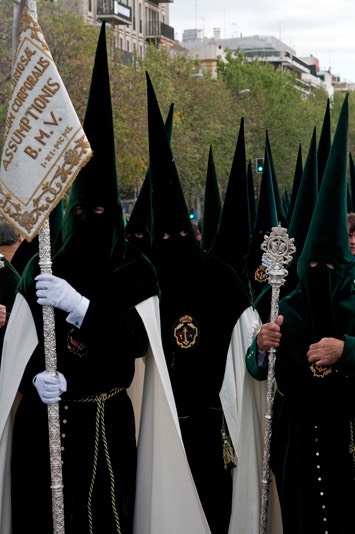


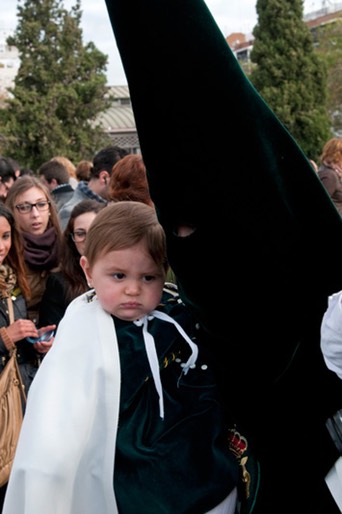




The sacred focus of the Triana procession is the float with the Virgin on it. While people chatter away with each other while the nazarenos pass, as soon as the virgin appears everybody immediately falls silent. This float carries one of the most revered images of all Easter processions in Sevilla, and many people attempt to touch it or at least take a photograph of it.




Eventually, some ten hours after leaving, the float with the virgin and the last nazarenos cross the bridge back into Triana, from which point it will take them another two hours or more to return to their church. After the processions ended, one can still see many tired nazarenos walking the streets on their way home and a few hard earned hours of sleep!





